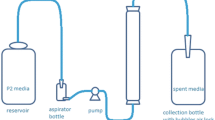Conclusions
Both S.cerevisiae and Z.mobilis were found to be capable of producing ethanol from glucose in both batch and continuous cultures in the presence of low concentrations of acid-recovery solvents in the medium. However, Z.mobilis seemed to be more sensitive to the solvents when the concentrations were high or when two or more solvents were present in the medium. Among the three solvents tested, 1-hexanol had the most inhibitory effects, followed by acetophenone and then hexane. This order agrees will with the order of solubility in aqueous medium.
In comparing the continuous ICR with the batch reactor, it was found that the ICR yielded significantly higher volumetric productivities and tolerated higher concentrations of solvents. Low concentrations of solvents in the feed medium may, in fact, help to alleviate cell overgrowth, thereby increasing column longevity.
The limiting concentrations of solvents in the medium for both batch and immobilized-cell reactors are summarized in Table 4. The limiting concentration in batch culture was estimated as the maximum concentration permitting complete glucose uptake in a period not exceeding twice the time for complete conversion without solvent. The limiting concentration in the continuous ICR was estimated as the maximum allowable concentration not resulting in a decrease in volumetric productivity. Each of these values was estimated from the available data.
Similar content being viewed by others
References
Chibata, I., Tosa, T., and Sato, T. (1983),Adv. Biotechnol. Proc. 1, 203–222.
Linko, P., Sorvari, M., and Linko, Y. Y. (1983),Annals NY Acad. Sci.. 413, 424–434.
Rogers, P. L., Lee, K. J., Skotnicki, M. L., and Tribe, D. E. (1982),Adv. Biochem. Eng. 23, 37–84.
Bailey, J. E., and Ollis, D. F. (1986),Biochemical Engineering Fundamentals, 2nd ed. (McGraw-Hill, New York), p. 384.
Montenecourt, B. S. (1985),Biology of Industrial Microorganisms (Demain, A. L. and Solomons, N. A., eds.), BenJaminJCummings, Menlo Park, CA, p. 261.
Lawford, H. G. (1988),Appl. Biochem. Biotechnol. 17, 203–219.
Waldron, R. D., Vega, J. L., Clausen, E. C, and Gaddy, J. L. (1987),Appl. Biochem. Biotechnol. 18, 127–142.
Vega, J. L., Wu, J. J., Boyer, L. J., Clausen, E. C, and Gaddy, J. L. Paper presented at the American Institute of Chemical Engineers Annual Meeting, New York, November, 1987.
Vega, J. L., Clausen, E. C, and Gaddy, J. L. (1987),Biotechnol. Bioeng. 29, 429–435.
Rogers, P. L., Lee, K. J., and Tribe, D. E. (1980),Process Biochem. 15(6), 7–11.
Gill, C. O., and Ratledge, C. (1972),J. Gen. Microbiol. 72, 165–172.
Vega, J. L., Navarro, A. R., Clausen, E. C, and Gaddy, J. L. (1987),Biotechnol. Bioeng. 29, 633–638.
Waldron, R. D. (1987), MS thesis, University of Arkansas, Fayetteville, AR.
Lewis, L. J. (1987), MS thesis, University of Arkansas, Fayetteville, AR.
Author information
Authors and Affiliations
Rights and permissions
About this article
Cite this article
Wu, J.J., Clausen, E.C. & Gaddy, J.l. A comparison of the effects of acetophenone, 1-hexanol, and hexane ons. cerevisiae and z.mobilis in batch and continuous immobilized-cell culture. Appl Biochem Biotechnol 28, 797–808 (1991). https://doi.org/10.1007/BF02922650
Issue Date:
DOI: https://doi.org/10.1007/BF02922650




